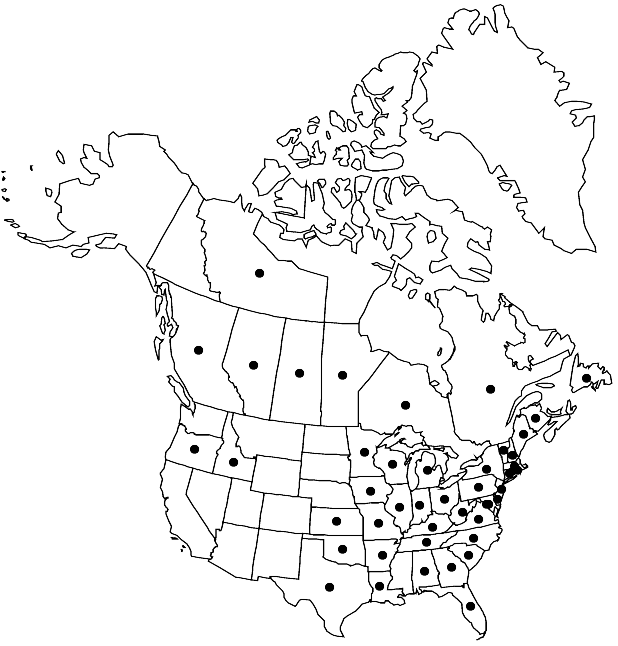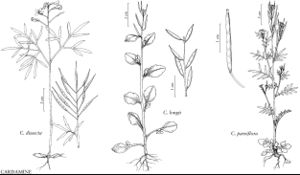Difference between revisions of "Cardamine parviflora"
Syst. Nat. ed. 10, 2: 1131. 1759.
FNA>Volume Importer |
imported>Volume Importer |
||
| (One intermediate revision by the same user not shown) | |||
| Line 6: | Line 6: | ||
|place=10, 2: 1131. 1759 | |place=10, 2: 1131. 1759 | ||
|year=1759 | |year=1759 | ||
| + | }} | ||
| + | |special_status={{Treatment/ID/Special_status | ||
| + | |code=W | ||
| + | |label=Weedy | ||
| + | }}{{Treatment/ID/Special_status | ||
| + | |code=F | ||
| + | |label=Illustrated | ||
}} | }} | ||
|basionyms= | |basionyms= | ||
| Line 57: | Line 64: | ||
|publication title=Syst. Nat. ed. | |publication title=Syst. Nat. ed. | ||
|publication year=1759 | |publication year=1759 | ||
| − | |special status= | + | |special status=Weedy;Illustrated |
| − | |source xml=https:// | + | |source xml=https://bitbucket.org/aafc-mbb/fna-data-curation/src/2e0870ddd59836b60bcf96646a41e87ea5a5943a/coarse_grained_fna_xml/V7/V7_740.xml |
|tribe=Brassicaceae tribe Cardamineae | |tribe=Brassicaceae tribe Cardamineae | ||
|genus=Cardamine | |genus=Cardamine | ||
Latest revision as of 22:35, 5 November 2020
Annuals; (slender); glabrous or sparsely to densely pubescent throughout. Rhizomes absent. Stems (simple or few to several from base), erect, (somewhat flexuous), often branched distally, (0.5–)1–3(–4) dm. Basal leaves (often withered by anthesis), usually not rosulate, pinnately (5 or) 7–13(–17)-foliolate, (2–)4–10cm, leaflets sessile or petiolulate; petiole 0.5–2.5(–4.5) cm; lateral leaflets similar to terminal, sometimes smaller; terminal leaflet (sessile or petiolule to 0.5 cm), blade linear to oblong, oblanceolate to obovate, or suborbicular, (0.1–)0.3–1 cm × 1–7 mm, base cuneate, margins entire or 3(–5)-toothed or -lobed. Cauline leaves 5–10(–14), (5–)9–15(–17)-foliolate, petiolate, leaflets sessile; petiole 0.3–1 cm, base not auriculate; lateral leaflets similar to terminal, sometimes smaller; terminal leaflet blade filiform, linear, or narrowly oblong, 0.3–1(–1.6) cm × 0.3–3 mm, margins usually entire, rarely 1–3-toothed. Racemes ebracteate. Fruiting pedicels divaricate or ascending, 4–10 mm. Flowers: sepals oblong, 1–1.5(–2) × 0.3–0.5 mm, lateral pair not saccate basally, (margins membranous); petals white, oblanceolate, (1.5–)1.8–2.5(–3) × 0.4–0.8(–1) mm; filaments 1.4–2.5 mm; anthers ovate, 0.2–0.4 mm. Fruits linear, (torulose), (0.5–)1–2(–2.5) cm × 0.6–0.9 mm; ovules 20–50 per ovary; style 0.3–0.7(–1) mm. Seeds pale brown, oblong-ovoid, 0.6–0.9 × 0.4–0.6 mm, (narrowly margined or not). 2n = 16.
Phenology: Flowering Mar–Jun.
Habitat: Roadsides, stream banks, rocky crests and outcrops, crevices of granitic bedrock, dry woods, glades, fallow fields, disturbed ground, limestone barrens, marsh and swamp margins, floodplains, waste ground, slopes, ledges, cliffs, meadows
Elevation: 0-1500 m
Distribution

Alta., B.C., Man., N.B., Nfld. and Labr. (Nfld.), N.W.T., Ont., Que., Sask., Ala., Ark., Conn., Del., D.C., Fla., Ga., Idaho, Ill., Ind., Iowa, Kans., Ky., La., Maine, Md., Mass., Mich., Minn., Mo., N.H., N.J., N.Y., N.C., Ohio, Okla., Oreg., Pa., R.I., S.C., Tenn., Tex., Vt., Va., W.Va., Wis., Eurasia.
Discussion
Within Cardamine parviflora, in the broad sense, two species or varieties have been recognized: the Eurasian C. parviflora (or C. parviflora var. parviflora) versus the North American C. arenicola (or C. parviflora var. arenicola). Nuclear DNA data suggested a sister relationship of the North American and Eurasian entities, while cpDNA data showed them intermingled (J. Lihová et al. 2006). There are no apparent morphological differences between these entities, although detailed morphological studies are still lacking. We currently prefer to treat them as a single taxon.
Selected References
None.
